Ask any Koodiyattam actor who his favourite character is and the answer will invariably be Ravana. Pose that question to a connoisseur and you may get the same answer. The fact is that Ramayana’s villain is the protagonist in Koodiyattam, and other traditional theatre forms of Kerala. Ravana offers the biggest challenge and the greatest potential for the actor; and the most aesthetic delight to the spectator.
So it was particularly apt that ‘Natyadharmi 22’ — the annual five-day festival organised by the central Sangeet Natak Akademy’s Kutiyattam Kendra — had Ravana as its theme. The event styled Natyaravanam, in which nearly 60 artistes took part, was curated in such a way that it conveyed the essence of what Koodiyattam is — the primacy of performance over story and the anti-hero cult that Kerala’s traditional performing artforms celebrated even a thousand years ago.
As Prof. K.G. Poulose, scholar and former vice-chancellor of Kerala Kalamandalam, noted in his speech at the inaugural session, Kerala’s Natyashastra tradition was not a replica of those followed in other parts of India. In Koodiyattam, focus is more on the presentation than the story. “While Natyashastra aimed to project an ideal hero and build up a story towards that ideal, Kerala tradition went beyond that and retained its focus on the mental process, not the story. .”
This is precisely what the sixth edition of Natyadharmi, the last two of which were held online, conveyed. A flight of imagination showing Ravana in all his moods — boastful, arrogant, victorious, pious, amorous, love-smitten, villainous and heroic.
It was no coincidence that of the 15 Ravanas presented, six were from Asokavanikankam, the fifth act of Sakthibhadra’s Ascharyachoodamani, which offers a big canvas to bring to the fore the histrionic effulgence synonymous with Koodiyattam. Presented in full for over 17 days, this act doesn’t advance the Ramayana story at all, though in its process Ravana straddles the three worlds with stories of his exploits, his dreams, his victories, and above all his love and passion. The act starts with Ravana describing Sita’s beauty and pouring out his love for her. At the end of the act, or after 17 days, we see Ravana sitting in the same state, bruised by unrequited love.
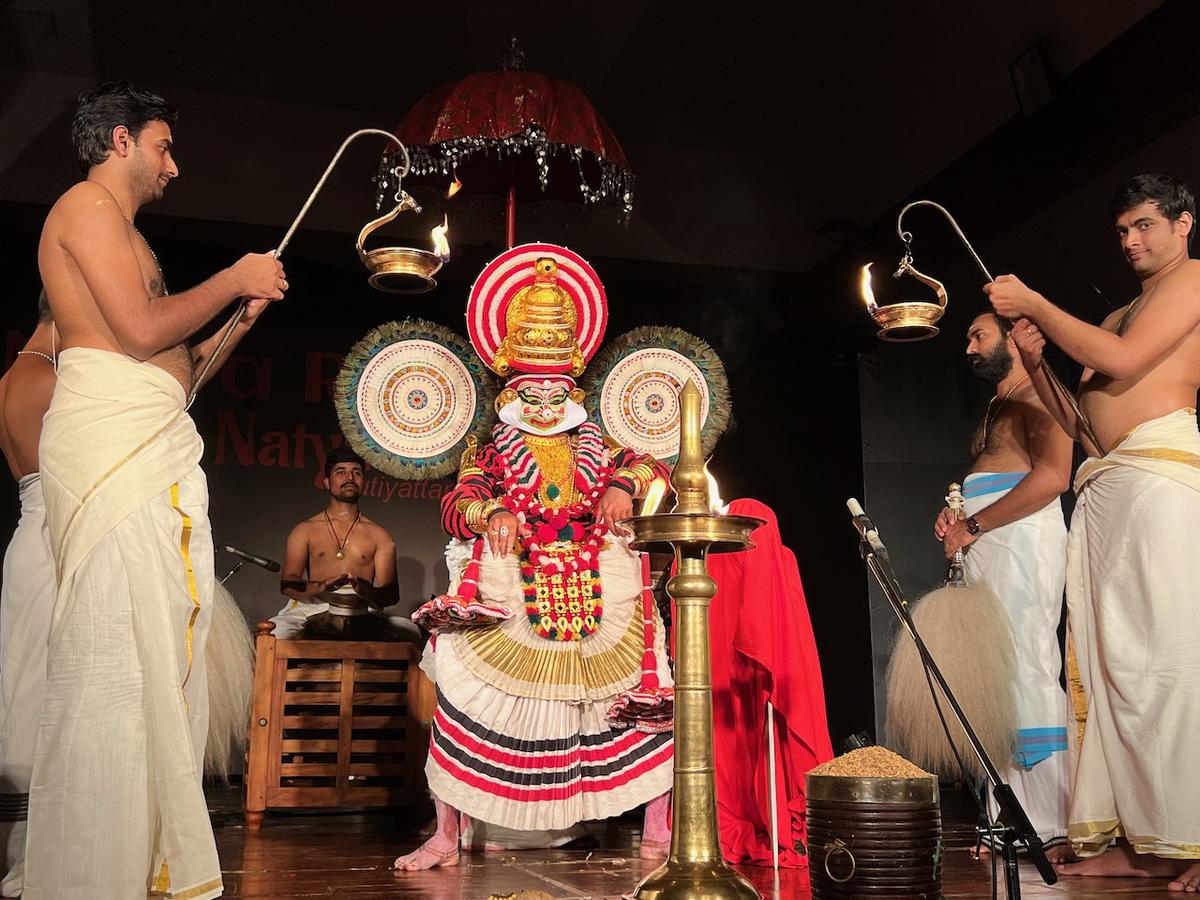
Margi Madhu Chakyar presenting Asokavanikankam – Valiya Udyanapravesam at Natyadharmi 22, organised by the central Sangeet Natak Akademy’s Kutiyattam Kendra.
| Photo Credit:
Special Arrangement
Mature approach
The festival’s finale was the last scene of Asokavanikankam — Valiya Udyanapravesam or grand entry into the garden, which is a visual spectacle and an ode to amour or shringara in all its hues, wooing Sita with gifts, blandishments and even threats. This is where Margi Madhu Chakyar showed his mastery over the form. In the solo act that Madhu edited to just over four hours, he displayed his maturity and experience in presenting this demanding and restrictive act where the actor moves just three or four ft in those four hours. The first section, describing Sita’s beauty called ‘Kesadipada’ took over an hour with the extremely slow delineation of mudras set to the 14-beat Dhruva tala.
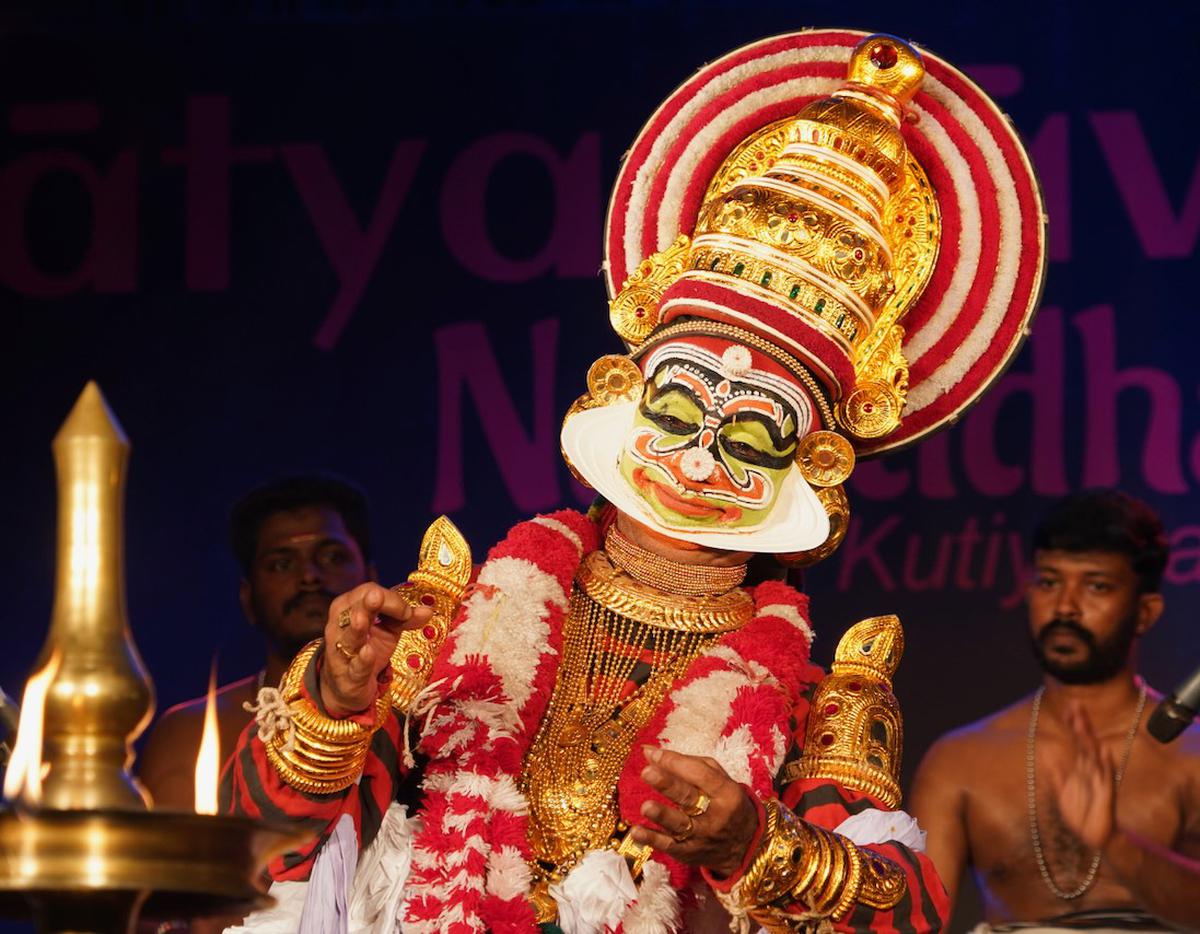
Margi Sajeev Narayana Chakyar presented Panadroopam, at Natyadhrami 22, organised by the central Sangeet Natak Akademy’s Kutiyattam Kendra.
| Photo Credit:
Special Arrangement
Love was again the theme when Margi Sajeev Narayana Chakyar presented panadroopam , where Ravana’s ten pairs of eyes feast on Sita’s beauty. Sitting on the stool and with his eyes and face in play, Sajeev observed the ten faces competing and fighting for Sita, pacified them and admonished them. In the last segment only the eyes come into play as the ten heads take in Sita’s beauty.
Sajeev with his hands folded on the chest presented a masterclass in concentration and netrabhinaya, moving his eyes in ten different ways.
Well-balanced act
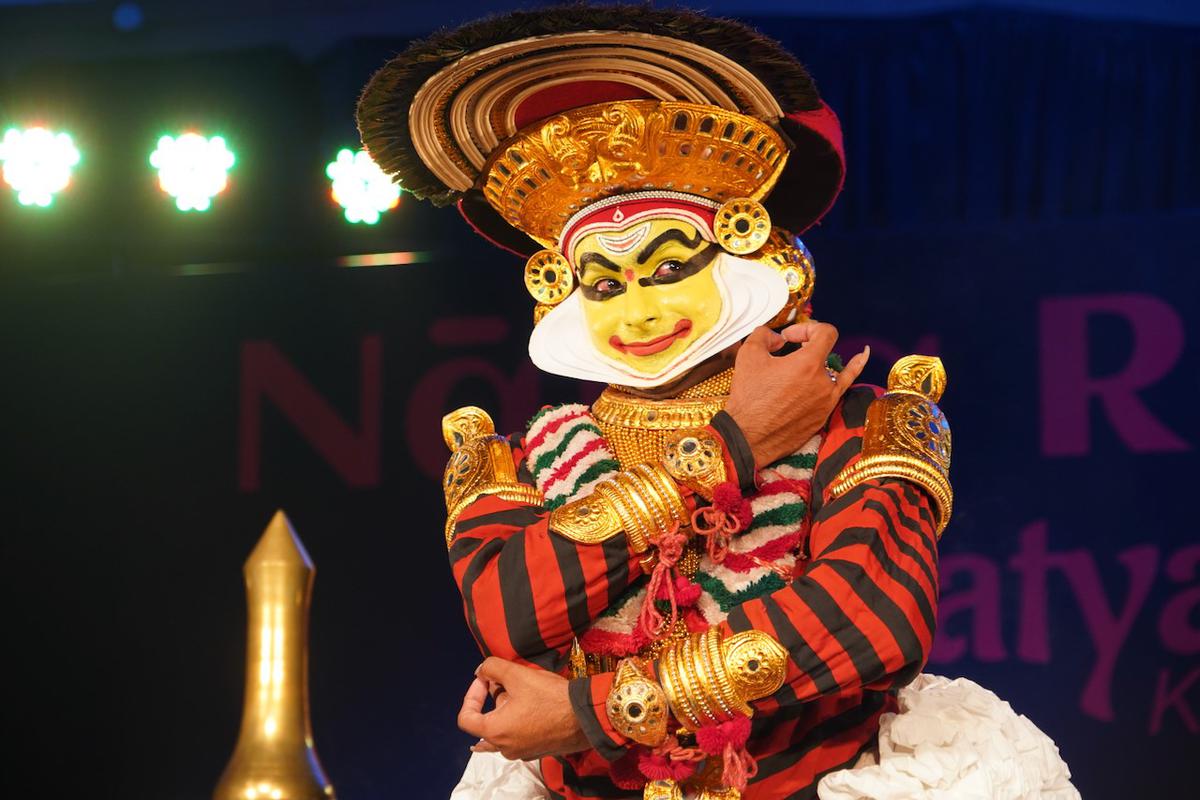
Rahul Chakyar depicted Sankukarna in Toranayudham, at Natyadharmi 22, organised by the central Sangeet Natak Akademy’s Kutiyattam Kendra.
| Photo Credit:
Special Arrangement
The Asokavanika garden again featured in Rahul Chakyar’s depiction of Sankukarna, in Toranayudham, where the gardener reports to Ravana that his garden has been destroyed by a monkey. He goes on to describe Ravana’s love for his garden by describing how he brought the plants and trees and creepers from heaven and planted them himself. And how Ravana stopped the wind from blowing and banished the Sun from Lanka to protect his plants from which even his wife Mandodari doesn’t dare to pick a leaf. The highlight of Rahul’s performance was a segment called koppaniyikkal or the maids helping Mandodari apply make-up and get dressed. Rahul’s transformation into femininity was beautiful to watch.
Interestingly, while the softer side of Ravana, as an aesthete, an admirer of beauty and an ardent lover was presented by three men, the valiant and arrogant faces of Ravana were presented by three women — Usha Nangiar, Aparna Nangiar and Kalamandalam Sangeeta. They displayed how the Koodiyattam acting device known as pakarnnattam, or transformative acting, allows a female artiste to present on stage even the most villainous male character.
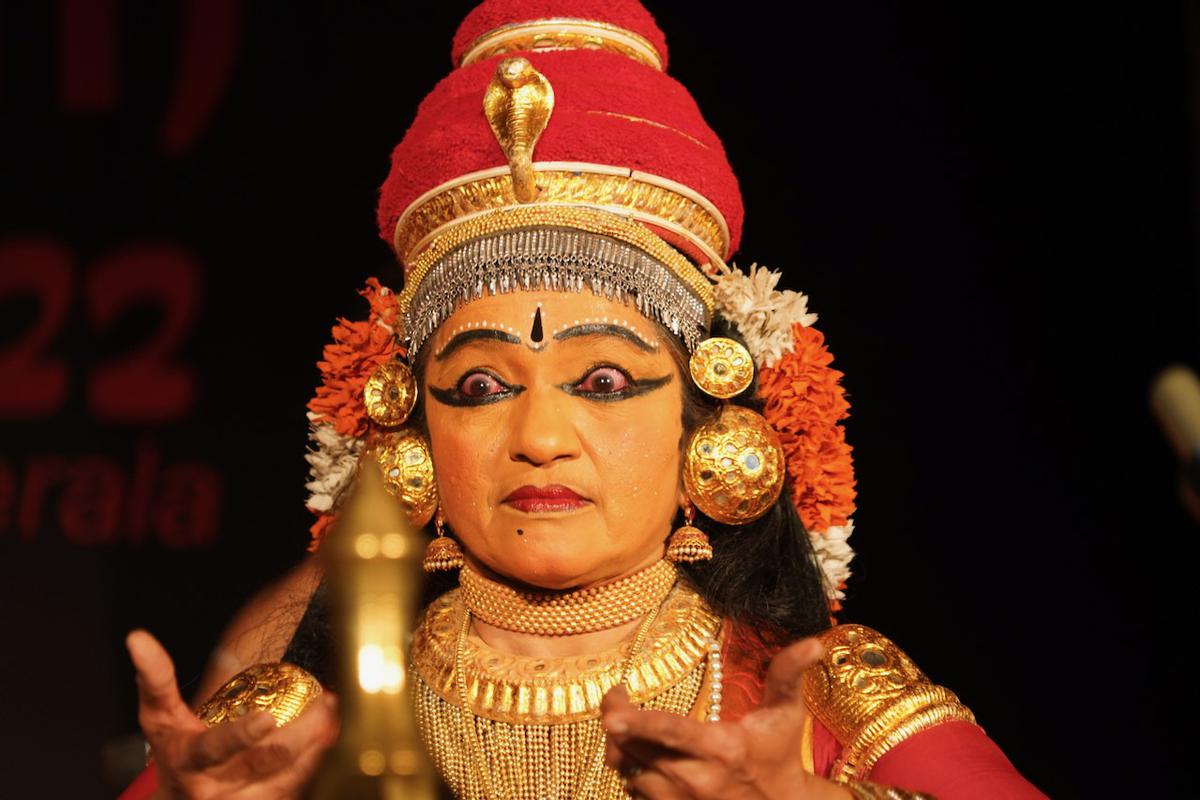
Usha Nangiyar at Natyadharmi 22, organised by the central Sangeet Natak Akademy’s Kutiyattam Kendra.
| Photo Credit:
Special Arrangement
Usha presented Mandodari’s nirvahanam or retrospective from Asokavanikankam, a three-day section she reintroduced to Koodiyattam repertoire after it was lost over the years. As Mandodari wakes up from a nightmare about the destruction of Lanka, her thoughts go back to her own life and that of Ravana. Usha presented the action-packed tapassattam where Ravana, doing severe penance, chops off his heads one by one till Lord Shiva appears and grants him near-immortality. Usha’s depiction of Ravana — with fire in his eyes, while impatiently waiting for Shiva, and the glow in his eyes when he sees his bride Mandodari — was fascinating.
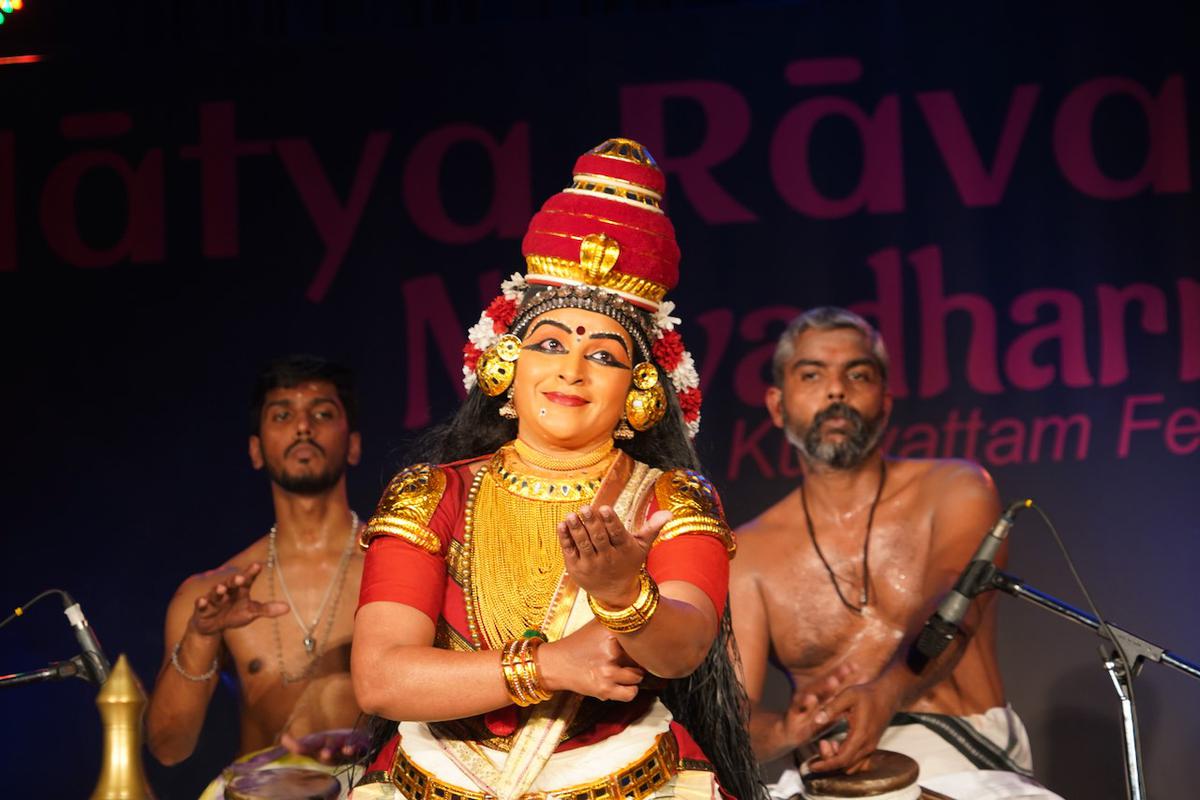
Kalamandalam Sangeeta Mandodari’s Nirvahanam at Natyadharmi 22, organised by the central Sangeet Natak Akademy’s Koodiiyattam Kendra.
| Photo Credit:
Special Arrangement
This same episode of Ravana’s penance was performed by Ammannur Rajaneesh Chakyar from a different perspective. Presenting a new choreography of Mahaveeracharitam by the 8th century playwright Bhavabhooti, Rajaneesh revealed the arrogant Ravana boasting to Mandodari how brave and powerful he was in executing this impossible task.
Kalamandalam Sangeeta presented another part of Mandodari’s Nirvahanam to describe how Ravana won the three worlds. She impressed with her verve and energy in presenting the popular episode of Ravana lifting Mount Kailasa and how he receivedhis famous sword Chandrahasa from Shiva.
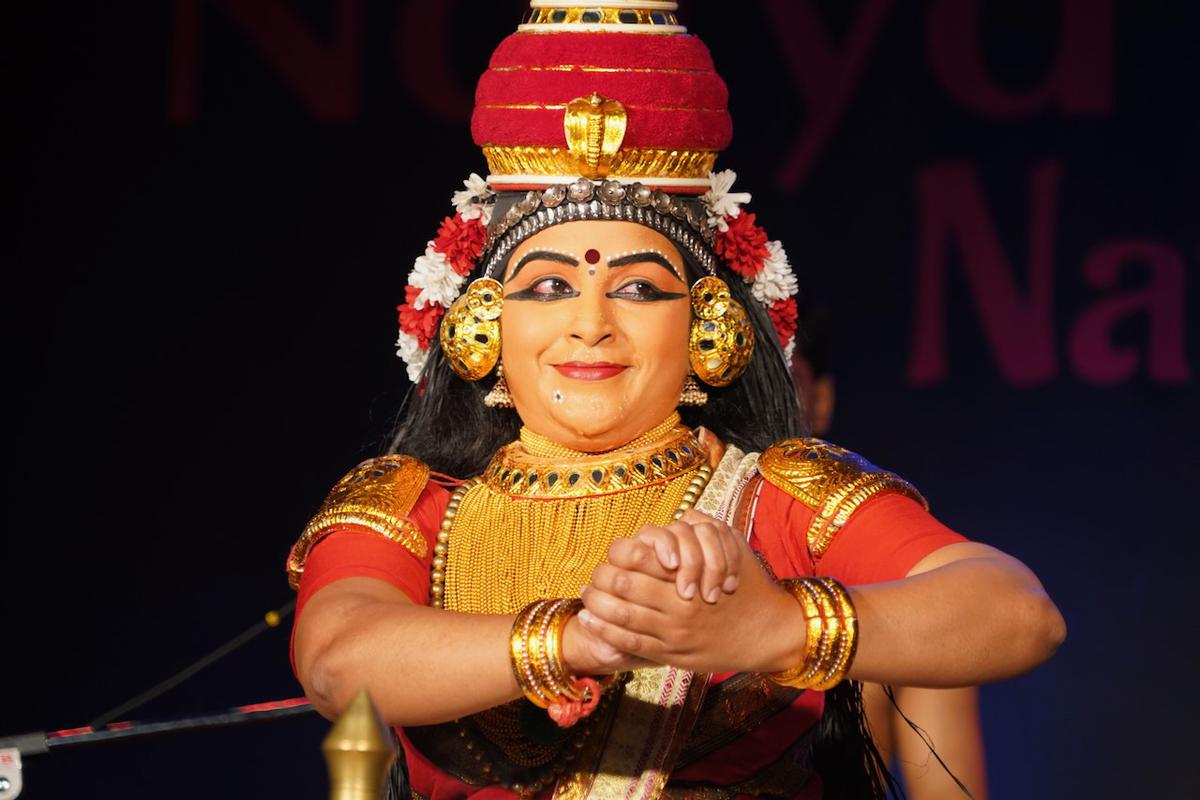
Kalamandalam Sangeeta presented another part of Mandodari’s Nirvahanam at Natyadharmi 2022, organised by the central Sangeet Natak Akademy’s Koodiyattam Kendra.
| Photo Credit:
Special Arrangement
“Presenting the same character in different episodes, and from different perspectives, was a deliberate choice to showcase the aesthetics of this artform”, says Kannan Parameswaran, director of Kutiyattam Kendra, who curated this festival. Says Kannan: “Our main concern was in trying to edit these episodes to a manageable three hours or so. Koodiyattam is inherently minute, detailed, repetitive and digressive. What we tried to do at this festival was to present this aesthetics of Koodiyattam, without losing its original details, to a newer and younger audience.”
For all the latest Entertainment News Click Here
For the latest news and updates, follow us on Google News.
